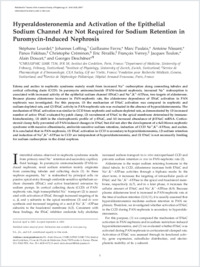Hyperaldosteronemia and activation of the epithelial sodium channel are not required for sodium retention in puromycin-induced nephrosis
- Lourdel, Stéphane CNRS/UPMC UMR Institut des Cordeliers, Paris, France
- Loffing, Johannes Department of Medicine, University of Fribourg, Switzerland
- Favre, Guillaume CNRS/UPMC UMR Institut des Cordeliers, Paris, France
- Paulais, Marc CNRS/UPMC UMR Institut des Cordeliers, Paris, France
- Nissant, Antoine CNRS/UPMC UMR Institut des Cordeliers, Paris, France
- Fakitsas, Panos Institute of Physiology, University of Zurich, Zurich, Switzerland
- Créminon, Christophe Service de Pharmacologie et d’Immunologie, CEA Saclay, Gif sur Yvette, France
- Féraille, Eric Fondation pour Recherche Médicale, Geneva, Switzerland
- Verrey, François Institute of Physiology, University of Zurich, Zurich, Switzerland
- Teulon, Jacques CNRS/UPMC UMR Institut des Cordeliers, Paris, France
- Doucet, Alain CNRS/UPMC UMR Institut des Cordeliers, Paris, France
- Deschênes, Georges CNRS/UPMC UMR Institut des Cordeliers, Paris, France - Service de Néphrologie Pédiatrique, Hôpital Armand-Trousseau, Paris, France
-
02.11.2005
Published in:
- Journal of the American Society of Nephrology. - 2005, vol. 16, no. 12, p. 3642-3650
English
Edema and ascites in nephrotic syndrome mainly result from increased Na+ reabsorption along connecting tubules and cortical collecting ducts (CCD). In puromycin aminonucleoside (PAN)-induced nephrosis, increased Na+ reabsorption is associated with increased activity of the epithelial sodium channel (ENaC) and Na+,K+-ATPase, two targets of aldosterone. Because plasma aldosterone increases in PAN-nephrotic rats, the aldosterone dependence of ENaC activation in PAN nephrosis was investigated. For this purpose, (1) the mechanism of ENaC activation was compared in nephrotic and sodium-depleted rats, and (2) ENaC activity in PAN-nephrotic rats was evaluated in the absence of hyperaldosteronemia. The mechanism of ENaC activation was similar in CCD from nephrotic and sodium-depleted rats, as demonstrated by (1) increased number of active ENaC evaluated by patch clamp, (2) recruitment of ENaC to the apical membrane determined by immunohistochemistry, (3) shift in the electrophoretic profile of γ-ENaC, and (4) increased abundance of β-ENaC mRNA. Corticosteroid clamp fully prevented all PAN-induced changes in ENaC but did not alter the development of a full-blown nephrotic syndrome with massive albuminuria, amiloride-sensitive sodium retention, induction of CCD Na+,K+-ATPase, and ascites. It is concluded that in PAN-nephrosis, (1) ENaC activation in CCD is secondary to hyperaldosteronemia, (2) sodium retention and induction of Na+,K+-ATPase in CCD are independent of hyperaldosteronemia, and (3) ENaC is not necessarily limiting for sodium reabsorption in the distal nephron.
- Faculty
- Faculté des sciences et de médecine
- Department
- Département de Médecine
- Language
-
- English
- Classification
- Biological sciences
- License
- License undefined
- Identifiers
-
- RERO DOC 5439
- DOI 10.1681/ASN.2005040363
- Persistent URL
- https://folia.unifr.ch/unifr/documents/299881
Statistics
Document views: 60
File downloads:
- 1_loffing_hae.pdf: 172
